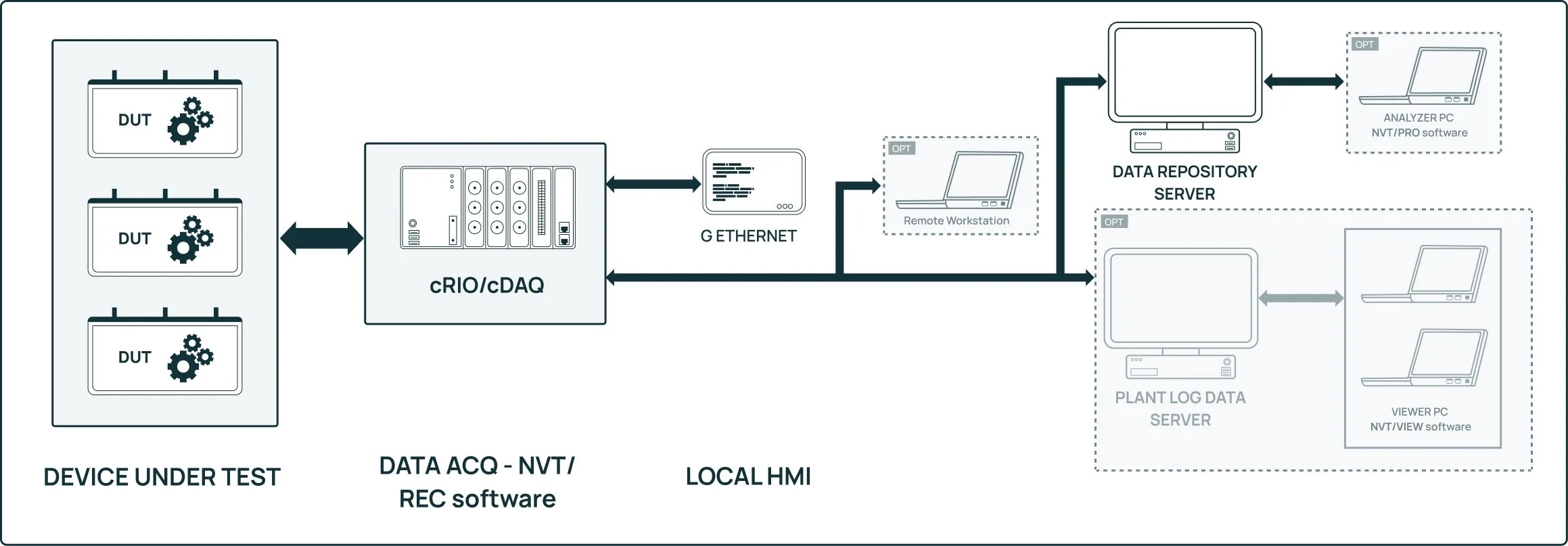NVT - Health Monitoring System
Integrated System for Vibration and Dynamic Parameter Monitoring
NVT/HMS is an integrated system with a distributed architecture, dedicated to monitoring vibrations and dynamic parameters of industrial plants, civil structures, and rotating machinery. Its extremely simple architecture and user flexibility allow it to perform monitoring tasks for both small systems and large-scale plants.
-
Monitoring systems for plants help maintain or restore integrity, limit degradation, and extend the service life by monitoring operating and usage conditions. They offer advantages such as maintenance optimization, fault prevention, and enhanced safety.
Typical tools include vibration measurement, temperature monitoring, electrical consumption, and analysis of lubricating oils. Traditional techniques, based on separate phases and post-operative analysis, require skilled operators to correlate the data.
The NVT-HMS system, thanks to its modern architecture, enables real-time measurements and validations based on operational conditions, transmitting only validated data. For example, it monitors vibrations in an electric motor by considering different operating conditions (off, variable speed, constant speed), excluding insignificant measurements. This simplifies control, making data immediately available and useful, overcoming the limitations of traditional systems.
-
The NVT-HMS monitoring system uses a distributed architecture with acquisition modules capable of conditioning, processing, and sending validated measurements in real-time to the server. It consists of:
Measurement Transducers/Bench Control Systems (Field Bus)
DAU Units (4-32 channels) for signal conditioning, acquisition, and processing
Embedded Computing Units (cRIO/cDAQ)
Client/Server Software with modules for real-time acquisition and analysis (NVT-HMSrec), server and historical data management (NVT-HMS-server), and monitoring up to 10 users (NVT-HMS-viewer).
The system ensures flexibility and advanced data management.
-
The NVA-HMS is utilized across multiple sectors, thanks to its flexibility and advanced capabilities:
Automotive: NVH (Noise, Vibration, Harshness) analysis, testing of engines, transmissions, and mechanical components.
Civil and Structural: Measurement of vibrations in buildings, bridges, and infrastructure for safety assessments.
Electronics: Testing of vibration-sensitive devices, such as printed circuit boards and microelectronic components.
Transportation and Defense: Performance evaluation of land, maritime, and military vehicles under extreme operating conditions.
-
Hardware
DAU Systems with cRIO/cDAQ Embedded Architecture
AD Converters: 16 and 24-bit Delta Sigma, up to 102.4 kS/s/channel
Anti-Aliasing Filters and Simultaneous Sampling
Transducer Power Supply: For IEPE and MEMS transducers
Protocol Management: Supports CAN/Modbus/Profibus/EthernetIP
Dynamic Range: Up to 100 dB
Ethernet Connection: 100M/1G
Local Processor: Up to Intel Quad-core
Operating System: Linux Real-Time
Local Storage: SSD/SD card up to 512 GB
Power Supply: 9-32 Vdc
Software
User-Managed Channel/Measurement/Alarm Setup
Real-Time Acquisition, Processing, and Monitoring
Measurement Recording and Event Streaming: On user request, on alarm, and time-based
Real-Time Display: Measurement graphics and trends
Signal Analysis in Post-Processing
Signal Conditioning: Scaling, Integration, Differentiation, Tachometric Synthesis
Frequency Domain Analysis: FFT Magnitude and Phase - Order Tracking Magnitude and Phase
Special Analyses: Bearing Order Tracking - Orbits - Gear Mesh Analysis - Torsional Analysis
Alarms: Absolute Value/Trend/BaseLine Time - FFT - Order Tracking
dBASE Management: Measurements and Events
Historical Search: Measurements and Events
Search by Measurement/Alarm
Search Streaming Signal Events
HARDWARE ARCHITECTURE: Multi DUT - Multi NI cRIO/cDAQ
HARDWARE ARCHITECTURE: Multi DUT - Single NI cRIO/cDAQ
REAL-TIME SOFTWARE ARCHITECTURE: The NVT-HMS system uses a real-time architecture with virtual channels for each input, sending only validated measurements and recording signals for future analysis. The flexible configuration easily adapts to monitoring needs.




